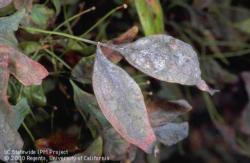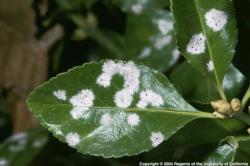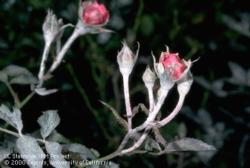Managing Powdery Mildew on Ornamentals
Powdery mildew is a common disease on many types of plants. It is easily recognized by the white, powdery mycelia and spore growth that appears on leaves and shoots. Different powdery mildew fungi cause disease on different plants. The best method for managing powdery mildew is prevention. Avoiding the most susceptible cultivars, placing plants in full sun, and following good cultural practices will adequately control powdery mildew in many situations. Some ornamentals do require protection with fungicide sprays if mildew conditions are more favorable, especially susceptible varieties of rose and crape myrtle. Cultural Practices Shade and moderate temperatures favor most powdery mildews. Locate plants in sunny areas as much as possible, provide good air circulation, and avoid excess fertilizing or use a slow-release fertilizer. Overhead sprinkling may actually reduce the spread of powdery mildew, because it washes spores off the plant. Also, if spores land in water, they die. The best time to irrigate is mid-morning so plants dry rapidly, reducing the likelihood of infections by other fungi such as ones that cause rust or black spot on roses. As new shoots begin to develop on perennial plants, watch closely for signs of powdery mildew.
Fungicide Applications
In some situations, especially when growing roses, you may need to use fungicides, which function as protectants, eradicants, or both. A protectant fungicide prevents new infections from occurring, whereas an eradicant can kill an existing infection. Apply protectant fungicides to highly susceptible plants before the disease appears. Use eradicants at the earliest signs of the disease. Once mildew growth is extensive, controlling the situation with any fungicide becomes more difficult.
Fungicides
Several least-toxic fungicides are available, including horticultural oils, neem oil, jojoba oil, sulfur, and the biological fungicide Serenade. With the exception of the oils, these materials are primarily preventive. Oils work best as an eradicant but also have some protectant activity.
Oils
To eradicate mild to heavy powdery mildew infections, use a horticultural oil such as JMS Stylet Oil, Saf-T-Side Spray Oil, Sunspray Ultra-Fine Spray Oil, or one of the plant-based oils such as neem oil (e.g., Powdery Mildew Killer). Be careful, however, never to apply an oil spray within two weeks of a sulfur spray, or it may injure plants. Also, you should never apply oils when temperatures are higher than 90°F or to water-stressed plants. Some plants may be more sensitive than others, and the interval required between sulfur and oil sprays may need to be even longer. Always consult the fungicide label for any special precautions. Of the horticultural oils, JMS Stylet Oil is the most highly refined and therefore the least likely to damage plants, but it may be more difficult to obtain than the others.
Sulfur
Sulfur products have been used to manage powdery mildew for centuries but are effective only when applied before the disease appears. The best sulfur products to use for powdery mildew control in gardens are wettable sulfurs that are specially formulated with surfactants similar to those in dishwashing detergent (e.g., Safer Garden Fungicide). Sulfur can damage some ornamental cultivars. To avoid injuring any plant, don’t apply sulfur when the temperature is near or higher than 90°F, and don’t apply it within two weeks of an oil spray.
Biological Fungicides
Biological fungicides (e.g., Serenade) are commercially available beneficial microorganisms formulated into a product that, when sprayed on the plant, destroy fungal pathogens. The active ingredient in Serenade is a bacterium, Bacillus subtilis, which helps prevent the powdery mildew from infecting the plant. These products have some effect in killing the powdery mildew organism but aren’t as effective as the oils or sulfur.
Synthetic Fungicides
Myclobutanil (Immunox) is also available to the home gardener and functions as an eradicant and protectant against both powdery mildew and rust. How to Use. Apply protectant fungicides to susceptible plants before or in the earliest stages of disease development. Once mildew growth is mild to moderate, it generally is too late for effective control with protectant fungicides. These are effective only on contact, so applications must thoroughly cover all susceptible plant parts. However, eradicant fungicides can reduce existing infections. As plants grow and produce new tissue, additional applications may be necessary at seven- to 10-day intervals as long as conditions favor disease growth.
—Excerpted with modifications from Pest Notes: Powdery Mildew on Ornamentals by Doug Gubler, Plant Pathology, UC Davis, wdgubler@ucdavis.edu; and Steven Koike, UC Cooperative Extension, Monterey Co., stkoike@ucdavis.edu.






